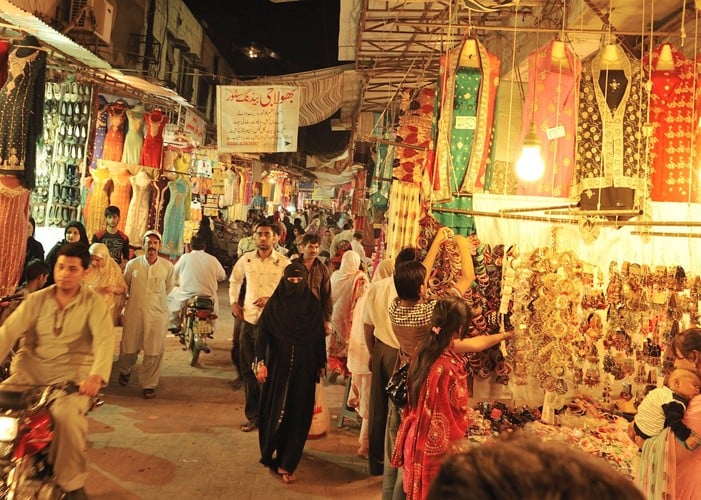
A party that mingles ideology, constituency and economy to become a model of unprecedented success

For the moment, the PML-N seems invincible; ready even to win the general election and form the next government. It has weathered a fiery dharna, shooting and killing of innocent people at the hands of police in Lahore’s Model Town and has won most by-elections and local body elections in its base -- Punjab. It has also come out unscathed from the recently-concluded bloody PIA strike.
What is it about the party that has turned it into a model of such unprecedented success? More importantly, where does it stand ideologically and what distinguishes it from its natural rival, the Pakistan Tehreek-i-Insaf (PTI), also representing the rightwing urban middle class?
After an election that had literally wiped the liberal progressive forces off the political map, the emerging PML-N government went on to assert it wanted to see a ‘liberal Pakistan’ and nothing less. The contradiction was hard to miss when prime minister celebrated Diwali with the Hindus in Karachi and uttered words that virtually paint Pakistan in a secular image. And there is a substantial pro-women legislation emanating from the Punjab Assembly and women being trained to ride motorcycles in Lahore.
Suhail Warraich, a senior analyst, thinks the best thing about the PML-N is its ability to transform readily. "They used to be pro-establishment, they now consider themselves the opposite, they were anti-India but that too has changed, they sided with Ziaul Haq and now they call themselves democrats."
Though unlike the progressive parties, PML-N lags behind in its empathy for culture and history. Or the priorities are such that it doesn’t care. Thus the people of Lahore have lost their centuries’ old basant, while the government sits comfortably because it doesn’t get bad press that it used to after each accident. The tacit support from the religious lobby is an added advantage.
The priorities include mass transit projects which in a city like Lahore threaten to obliviate the historical monuments from sight and mind. But it seems the race to get votes takes precedence over protecting history.
The party may have made tactical adjustments and neutralised its stand on certain issues after having come into power, its ideological base remains, gelling well with its constituency and economic policy. Warraich thinks it is basically "rightwing, Punjabi, middle class, business. It is the backbone for them [Sharifs] and they know how to twist it or use it."
As said earlier, the ideology of PML-N mixes well its economic mantra and political commentator Nusrat Javeed sums up its key themes of governance as "less government, business-friendly, pro-status quo, less taxes, mega project oriented, export-driven, with connectivity for all people in its constituency".
The Sharifs can’t be blamed because the Lahore Islamabad Motorway is the crowning achievement for the party so far. Besides, the way chief minister Punjab successfully managed the metro bus earned them the 2013 victory.
Javeed thinks that before we discuss the PML-N’s success, one must read Vali Nasr’s Forces of Fortune "in which he says that it is important to understand the emerging business class in the Muslim world".
"It is the upwardly mobile class, the bazaar, the business group that will be the agents of change [Nasr is talking with reference to Islamic extremism]. It is the market economy, the glittering lights [that will neutralise extremism] and the illusion that it creates of pulling most of these voters to upward scales. PML-N opens up this possibility, not impedes it," says Javeed. "Nasr talks of Turkey but he even sees Iran’s deal with the West in this backdrop."
This partly explains the PML-N’s closeness with Turkey.
Read also: PMLN — anti or pro-establishment
Both Javeed and Warraich assert that it is the urban middle class that has become a deciding factor in changing the political fortunes and in that respect Punjab assumes a special advantage. That is where the PML-N is pitched against the PTI.
"The PTI is also a middle class party but it represents the deprived aspirations of that class. It has professional classes on its side but the PML-N has all others -- it has in its control the strongman of the street as well as the maulvi," says Warraich.
In Javeed’s view, the PTI is supported by LUMS-brand merit-based corporate sector while the trader in Anarkali who prefers to give zakat instead of taxes is still the supporter of PML-N. "In Punjab, the dominant thinking, what you call narrative or discourse, is the one held by that urban middle class."
PML-N has consistently ignored agriculture as well as the constituency associated with agriculture. That’s peculiar in a country like Pakistan where it is difficult to separate the economy from agriculture. "They have never considered agriculture their constituency. They know that it’s the Punjab that makes or breaks the prime minister and in Punjab, except the small Southern tale, the urban rural divide is non-existent. Even in small villages, there is cable tv, connectivity and communication networks, overseas people and their conservative ideology," says Javeed.
Basically, the Sharifs want to appear as good managers of economy as well as ideology and they do. But how long will they be able to sustain this position of strength?
Historically, such a strong position has never been liked much by the country’s establishment and military takeovers have followed. Since that doesn’t look too likely this time, will the challenge to their own authority come from within the family, once it’s time for the next election?
People have already started speculating whether Mian Mohammad Nawaz Sharif is interested in becoming a prime minister the fourth time. Analysts are divided, though some think he would. If not, will we see Shahbaz Sharif contesting for the slot? As of now, no analyst is ready to put his bets on him, because Nawaz Sharif, they say, is training his daughter Maryam for the job.